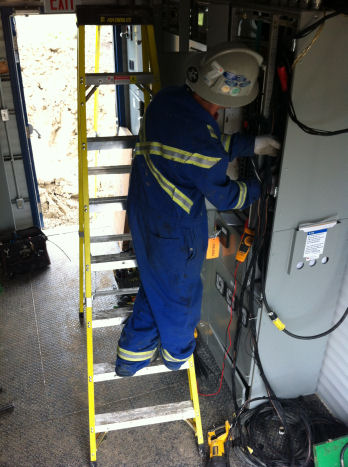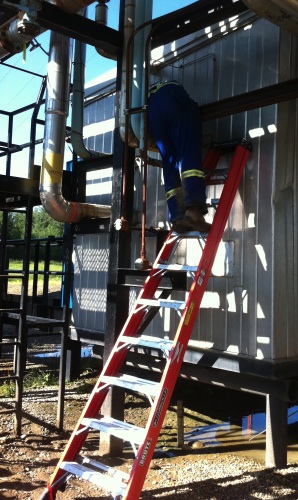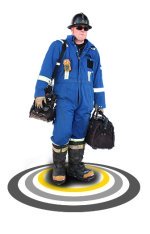Ladder Safety For Electricians: Don't Risk a Shock or a Fall
Why ladder safety should be a top priority!

You have to practice ladder safety at all times. One wrong move can land you in the hospital, or worse.
Much of the wire you install or repair in residential settings will be inside walls, and easy to work on from the floor.
But many times, especially in industrial buildings, you have to work on ladders. Most of the conduits in factories run along or near the ceiling.
Despite a huge selection of power lifting devices and aerial baskets, ladders still remain the only practical way to access many overhead work locations.
How Ladders Have Changed
The humble ladder was once a simple, portable set of wooden steps. Over time it has evolved into all sorts of sophisticated adjustable models that come in various styles.
There are many versions available designed specifically for certain trades, including electricians.
Ladder designs have not just transformed to provide convenience and additional ladder safety features, the materials used to make ladders have changed as well. Plus, there are now many accessories available to make your work easier and safer.
Even with the new advances in materials, wooden ladders are by no means obsolete. Electricians however, prefer to use fiberglass as it does not conduct electricity when either wet or dry.
The six- and eight-foot ladders, twin-step models and twenty-four and twenty-eight foot extension ladders are the most popular choices for electricians.
How Ladder Safety is Certified
Ladders are rated according to a duty rating system, which classifies ladders by strength and intended use.
The ANSI and OSHA enforce very strict testing to determine ladder safety standards, and to protect those who use the ladder.
Professional electricians usually prefer ladders rated for heavy duty use, as opposed to cheaper and flimsier models designed for casual use around the house.
Many ladder manufacturers have designed ladders for specific trades, and the Werner Ladder, designed specifically for electricians, is one of the best. This IAA heavy duty ladder has everything an electrician needs to make his job easier, like:
- Rated for a load capacity of up to 375 pounds
- Made of fiberglass
- Includes a holster top capable of holding your most needed tools with an adjacent groove designed to secure a one-inch pipe for quick marking and measuring
- Bungee design system to prevent tools from falling
- Integrated holder for conduit with safety shields to prevent the worker from accidentally cutting through the rails of the ladder
- A hacksaw hook
- Brackets for holding wire spools
All ladders designed for electricians come with special ladder safety features and hooks and brackets for carrying tools.
The adjustable A-frame design is also very popular for convenience and ladder safety reasons. To be the most useful and safe for an electrician, a ladder must:
- Be adjustable up to 21 feet for overhead lights in industrial builds or theaters
- 375 pound capacity which is capable of holding you plus all of your essential tools
- Be made of fiberglass and be equipped with a molded top and have enough slots or brackets to keep your tools safely within reach
- Have a webbed pole grip to secure the ladder to pipes, poles or corners
- Twin steps to allow two people to work together
- D-shaped rungs to provide a larger standing area
Wooden ladders are not ideal for an electrician because they can conduct electricity when wet or dirty.
Fibreglass ladders are heavier than aluminum models, but much safer when working with electricity. Most of them now come with built in leg levelers, which makes them much safer when working on uneven ground.
For extra convenience and safety, many electricians use V-rungs, cable hooks, pole lashes and straps to secure the ladder and prevent accidents.
Choose the Right Ladder
The most important part about working safely is to always use the proper equipment.

Most accidents happen when people try to cut corners, either to save time or money. This usually results wasting a lot of both and situations become more dangerous.
Use the right ladder and use the proper techniques for proper base set up and climbing.
Portable ladders are put into three basic categories:
- Type I – heavy duty industrial use with a load capacity less than 250 pounds.
- Type II – medium duty commercial use with a load capacity of less than 225 pounds. Suitable for painting and other low risk tasks.
- Type III – light duty household use with a load capacity less than 200 pounds.
Type I ladders made of fiberglass are the number one choice for electricians. They cost more, but are more durable and safer to use around electricity.
Use Ladder Safety Practices at all Times
The best way to prevent accidents and injuries is always use your equipment properly with workplace safety tips. This is very important when working on ladders.
- Get the right ladder for the job.
- Always inspect the ladder for cracks or broken joints.
- Set the ladder on an even and stable surface.
- Never put the ladder on top of something.
- The ladder should be one foot away from whatever it is leaning against, for every four feet of height.
- For an A-frame ladder, makes sure to lock the brace securely.
- When climbing onto a roof or other surface, extend the ladder at least three feet past the intended surface.
- Always lash or fasten tall ladders securely.
- Do not descend or climb with your back to the ladder.
- Always keep your feet on the rungs.
- Never climb all the way to the top.
Ladders, as with all equipment, must be kept clean and in proper working order. A small crack might not seem bad, but with all of the tools and wire you may be carrying, the extra weight could snap a rung. Always work as safely as possible.
Ladders are very useful tools. Just make sure to always practice proper ladder safety.





